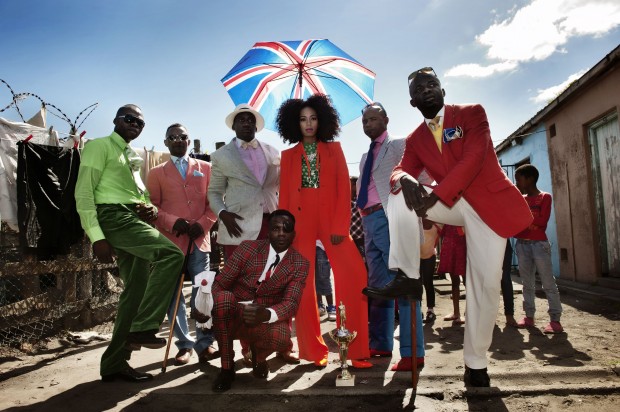 |
| The dirty streets cannot mitigate the sheer amount of swankiness these men emit |
The young men of
Brazzaville, capital city of the Republic of the Congo contrast dramatically
with the mud lined streets of their backdrop.
These young men who live on $300 a month, strut about in $1000 designer suits with an
aristocratic boldness and elegance that defies the poverty in which they
live. These are the members of la SAPE Société des
Ambianceurs et des Personnes Élégantes (The Society for the Advancement of Elegant People). The members themselves are referred to as
sapeurs. These modern dandies strive to embody elegance with their dress
and mannerisms. The sapeurs gather in
bars and cafes on weekends to flaunt their artfully arranged bright suits, and
their pricey designer labels.
So how did a
subculture of dandyism appear in in this war torn, impoverished nation?
 |
| Papa Wemba - Rumba musician, inspiration for sapeurs, and all around classy dresser |
At the turn of the
twentieth century, Brazzaville was capital of what the French called French
Equatorial Africa. Colonizers would
often pay their local houseboys with second hand clothing. The Congolese elite
was composed mainly of skilled laborers who moved from the coast to Brazzaville
to find work. These men inspired the
houseboys to reject the colonial ideas of inferiority taught to them. As an assertion of their equality, the poor
boys of Brazzaville rejected the second hand clothing of their employers and
dedicated themselves to obtaining the finest Parisian fashions, aristocratic
mannerisms, and attitudes, and making it distinctly their own. Anticolonialism became especially important
to the sapeurs in the 1940’s and 1950’s.
In the 1950’s Brazzaville as became a more cosmopolitan city, the
increasing numbers of bars and cafes fostered a Congolese Rumba scene that
popularized la SAPE. Musicians such as
Papa Wemba elevated la SAPE to the level of religion for many young Congolese
men. In the 1980’s the government of the
Republic of the Congo worked to bar sapeurs from public spaces and outlaw their
practice, seeing them as a threat to the government plans to return to more
traditional modes of dress and behavior.
For much of the last 25 years, war and economic instability has made it
impossible for sapeurs to exist in the Republic of the Congo. In recent years,
relative peace and the government reversing its stance on sapeurs has allowed
for la SAPE to reemerge as a subculture.
 |
| It takes true skill to make pink sunglasses look this refined. |
Sapeurs represent a
complex and fascinating phenomenon. On
the one hand, these men are spending many months worth of wages they
desperately need to improve their living circumstances in order to purchase the
tokens of luxury of their former colonial rulers. However, the sapeurs see it differently. In the words of Papa Wemba “white people
invented the clothes, but we made an art of it.” To the sapeurs, to dress elegantly is a form
of artistry, self-expression, and refusal to allow the conditions in which they
live define them as people. Understanding
the delicate relationship between the sapeurs, colonialism, and self-determination
is central to a proper understanding of the sapeurs. While one may question the relationship
between sapeurs and Congolese culture, one cannot question their artistry or
sense of style.
Sapeurs will pay
thousands of dollars for European designer suits, alligator shoes, canes, monocles,
and matching hats. Typically Congolese
men living in Paris will ravage end of the summer sales at Parisian boutiques,
and bring the suits back to Brazzaville and its sister city Kinshasa to sell to
young working class men. These men
strive to dress according to the most up to date fashion trends. Sapeurs wear daringly bright colored suits,
but will not wear more than three colors in one outfit. Through borrowing clothing from friends, they
avoid ever wearing the same ensemble twice. Rivalries exist between neighbooring cities, and indavidual sapeurs. They will often gather for 'fights' in which two sapeurs show off their fine attire, and designer labels in a sort of dance. The best dressed man is declared the winner.
 |
| As Solange Knowles proves, ladies can rock a suit just as well as their male sapeur counterparts. |
If you identify with
the sapeurs’ belief that elegance and dignity are a matter of choice, that
one’s circumstances cannot define a person, or simply like their snazzy style
there are a few ways to emulate their classy ways. While sapeurs are generally men, people of
any gender can rock a bright suit if they have the confidence to carry it
well. You certainly do not need to spend
thousands of dollars on a designer suit, and then wear it to a bar in order to
emulate sapeur style. Of course if you
wish to and can afford to do so, go for it.
For the rest of us, emulating the sapeur begins with carrying oneself with
a sense of self earned dignity and refinement.
Once you have mastered the courtesy and manners demanded of la SAPE, the
next avenue to consider is dress. Again,
the most obvious option is getting bright suits to wear to casual events. A more realistic option is wearing dress
pants, and a blazer when you go out or go to class, every now and then. This will seem strange at first, but if you
carry yourself with confidence and are somewhat consistent, people will simply
come to see you as a classy dresser. If
you are more intrigued by the bright artistry of the sapeurs, then focus on
that when you dress yourself. Instead of
wearing the standard black, white, and grey of business wear; add some creative
brightness. Try adding lavender,
yellows, pinks, or whatever attention grabbing colors you like to your dress
clothes. Experiment, and see how you can
express your personality and sense of class in your everyday and dress wear.